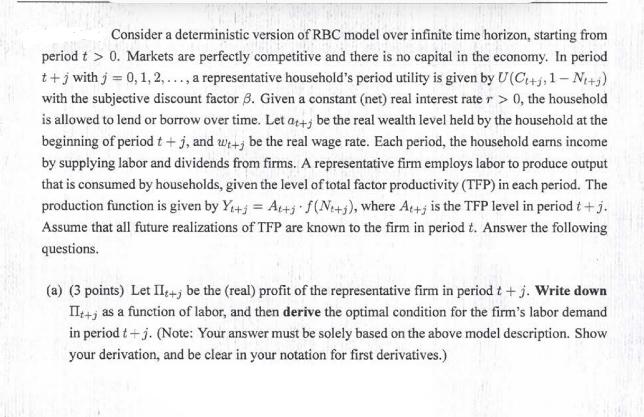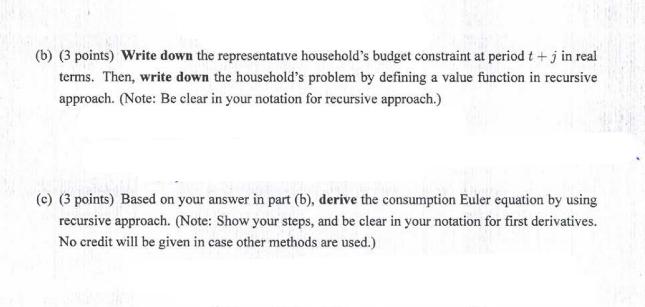Answered step by step
Verified Expert Solution
Question
1 Approved Answer
Consider a deterministic version of RBC model over infinite time horizon, starting from PUCH period t > 0. Markets are perfectly competitive and there


Consider a deterministic version of RBC model over infinite time horizon, starting from PUCH period t > 0. Markets are perfectly competitive and there is no capital in the economy. In period t+j with j = 0, 1, 2, ..., a representative household's period utility is given by U(Citj, 1- Ni+j) with the subjective discount factor 6. Given a constant (net) real interest rate r > 0, the household is allowed to lend or borrow over time. Let a++ be the real wealth level held by the household at the beginning of period t + j, and w+; be the real wage rate. Each period, the household earns income by supplying labor and dividends from firms. A representative firm employs labor to produce output that is consumed by households, given the level of total factor productivity (TFP) in each period. The production function is given by Yt+j = At+j f(N+j), where At+j is the TFP level in period t +j. Assume that all future realizations of TFP are known to the firm in period t. Answer the following questions. (a) (3 points) Let II,+ be the (real) profit of the representative firm in period t + j. Write down IIt+j as a function of labor, and then derive the optimal condition for the firm's labor demand in period t + j. (Note: Your answer must be solely based on the above model description. Show your derivation, and be clear in your notation for first derivatives.) (b) (3 points) Write down the representative household's budget constraint at period t +j in real terms. Then, write down the household's problem by defining a value function in recursive approach. (Note: Be clear in your notation for recursive approach.) (c) (3 points) Based on your answer in part (b), derive the consumption Euler equation by using recursive approach. (Note: Show your steps, and be clear in your notation for first derivatives. No credit will be given in case other methods are used.)
Step by Step Solution
★★★★★
3.41 Rating (160 Votes )
There are 3 Steps involved in it
Step: 1
a Profit of the representative firm in period t j denoted as t j can be expressed as the difference between total revenue and total costs In this case ...
Get Instant Access to Expert-Tailored Solutions
See step-by-step solutions with expert insights and AI powered tools for academic success
Step: 2

Step: 3

Ace Your Homework with AI
Get the answers you need in no time with our AI-driven, step-by-step assistance
Get Started


